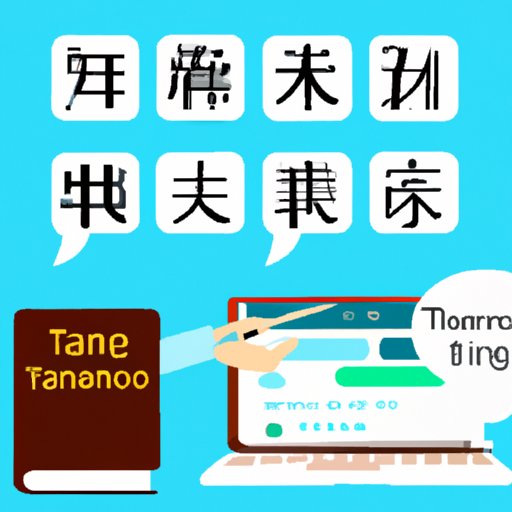Introduction
Chinese is one of the oldest written languages in the world. With its complex characters and unique writing style, it can be difficult for those who don’t speak or read Chinese to accurately translate the language. For people who want to learn more about Chinese writing, the task can seem daunting. However, there are a variety of resources available to help make the process easier.
The purpose of this article is to provide an overview of how to effectively translate Chinese writing, including utilizing online resources, working with professionals, and leveraging technology. By the end of this article, readers will have a better understanding of the steps needed to accurately translate Chinese writing.
Utilizing Online Translators
One of the most popular methods of translating Chinese writing is by using online resources. There are many websites and apps available that offer automated translation services. These services use algorithms to analyze a text and produce a translated version. While these services are convenient and often free, they do have limitations.
One of the main benefits of using an online translator is that it’s quick and easy to use. All you need to do is copy and paste the text you want to translate and the service will generate a translated version. Additionally, many online translators are free, so you don’t have to worry about spending money on a translation service.
However, while online translators can be useful, they are not always accurate. Because they rely on algorithms, they may not be able to capture the nuances of a language or account for cultural differences. Additionally, some online translators may not be able to accurately translate complex writing styles or literary texts. As such, it’s important to be aware of the limitations of online translators.
Some of the most popular online translation services include Google Translate, Microsoft Translator, and Baidu Fanyi. Each of these services offers different features, so it’s important to compare them to determine which one best meets your needs.
Learning Chinese Characters and Pronunciation
In order to effectively translate Chinese writing, it’s important to understand the basics of Mandarin, the primary dialect spoken in China. This includes understanding the characters used in writing as well as their correct pronunciation. Fortunately, there are a variety of resources available to help you learn the basics of Mandarin.
For those who want to learn the basics of Mandarin, there are many free and affordable resources available. Websites like Duolingo and Memrise offer courses in Mandarin that are designed to teach the language to beginners. Additionally, many universities and language schools offer classes in Mandarin, although these may come at a cost. YouTube also has a wealth of videos and tutorials that can help you learn the basics of Mandarin.

Working with a Professional Translator
If you need to translate a large amount of text or something that requires a high degree of accuracy, it may be worth considering hiring a professional translator. Professional translators are experienced in translating text and can ensure that your translation is accurate and reflects the original meaning of the text.
When hiring a professional translator, it’s important to consider their experience and qualifications. Look for someone who has experience translating Chinese writing and is familiar with the language and culture. Additionally, make sure to ask for references and check reviews to ensure that the translator is reliable and trustworthy.
It’s also important to consider the cost of hiring a professional translator. Depending on the size and complexity of the project, the cost can vary significantly. Be sure to get quotes from multiple translators and compare prices to ensure you get the best deal.

Understanding the Context of the Writing
In order to accurately translate Chinese writing, it’s important to understand the context of the text. This includes understanding the message of the text, the tone, and the intended audience. Additionally, it’s important to take into account any cultural considerations that may affect the translation.
When translating Chinese writing, it’s important to pay attention to key components such as slang, idioms, and colloquialisms. These can often change the meaning of a text and must be taken into consideration when translating. Additionally, it’s important to be aware of cultural differences that may affect the interpretation of a text. For example, certain words may have different connotations in different cultures.
Researching Cultural Backgrounds
In addition to understanding the context of the text, it’s also important to research the culture and background of the text. This can help to ensure that the translation is accurate and reflects the original meaning of the text. There are a variety of resources available to help with this task.
One of the best ways to research the cultural background of a text is to consult books, articles, and websites related to the topic. Additionally, speaking to native speakers or experts in the field can be helpful. This can provide insight into the cultural nuances of a text and help to ensure that the translation is accurate.
When researching the cultural background of a text, it’s important to keep an open mind. It’s possible that the cultural context of a text may differ from what is commonly accepted. As such, it’s important to be aware of the potential for differences and to interpret the information accordingly.

Leveraging Technology to Aid in Translating
In addition to utilizing online resources and working with professionals, another way to effectively translate Chinese writing is to leverage technology. There are a variety of tools and software available that can help with the translation process. These tools can be used to automate certain tasks or to provide additional support when translating.
Some of the most common tools used to aid in the translation process include machine translation systems, translation memory software, and post-editing tools. Machine translation systems use algorithms to automatically generate translations, while translation memory software stores previously translated material to help speed up the process. Post-editing tools allow users to edit and refine translations generated by machine translation systems.
While these tools can be helpful, it’s important to remember that they are not perfect. As such, it’s important to be aware of the limitations of these tools and to use them with caution. Additionally, it’s important to use these tools in conjunction with other methods of translation to ensure accuracy.
Conclusion
Translating Chinese writing can be a challenging task, but with the right resources and tools, it is possible to accurately translate the language. Utilizing online resources, working with professionals, and leveraging technology can all help to ensure that the translation is accurate and reflects the original meaning of the text. Additionally, understanding the context of the text and researching the cultural background can also be beneficial.
By following the steps outlined in this article, anyone should be able to effectively translate Chinese writing. With a little bit of effort and dedication, it is possible to accurately translate even the most complex Chinese texts.
(Note: Is this article not meeting your expectations? Do you have knowledge or insights to share? Unlock new opportunities and expand your reach by joining our authors team. Click Registration to join us and share your expertise with our readers.)
